Städel Museum
The Städel Museum, officially the Städelsches Kunstinstitut und Städtische Galerie, is an art museum in Frankfurt, with one of the most important collections in Germany. The Städel Museum owns 3,100 paintings, 660 sculptures, more than 4,600 photographs and more than 100,000 drawings and prints. It has around 4,000 m² of display and a library of 115,000 books.

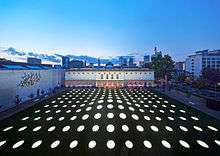
The Städel was honoured as "Museum of the Year 2012" by the German art critics association AICA in 2012. In the same year the museum recorded the highest attendance figures in its history, of 447,395 visitors.[1]
History
The Städel Museum was founded in 1817, and is one of the oldest museums in Frankfurt's Museumsufer, or museum embankment. The founding followed a bequest by the Frankfurt banker and art patron Johann Friedrich Städel (1728–1816), who left his house, art collection and fortune with the request in his will that the institute be set up.[2]
In 1878, a new building, in the Gründerzeit style, was erected on Schaumainkai street, presently the major museum district. By the start of the 20th century, the gallery was among the most prominent German collections of classic Pan-European art; the other such collections open to the public were the Dresden Gallery, the Alte Pinakothek in Munich, and the Altes Museum in Berlin.
World War II
In 1937, 77 paintings and 700 prints were confiscated from the museum when the National Socialists declared them "degenerate art".
In 1939, the collection was moved out of Frankfurt to protect it from damage in World War II. The collection of the Städel Museum was removed from the museum to avoid destruction from the Allied bombings, and the collection was stored in the Schloss Rossbach, a castle owned by the Baron Thüngen near Bad Brückenau in Bavaria. There, the museum's paintings and library were discovered by Lt. Thomas Carr Howe, USN, of the American Monuments, Fine Arts and Archives program. Although the Baron von Thüngen and his wife were uncooperative with the Americans, Frau Dr. Holzinger, a licensed physician and the Swiss wife of the Städel Museum director, was present at the site and assisted with the cataloging and the removal of the items to the Munich Central Collecting Point. Lt. Howe said, “The first room to be inspected was a library adjoining the sitting room in which we had been waiting. Here we found a quantity of excellent French Impressionist paintings, all from the permanent collection of the Städel Museum, and a considerable number of fine Old Master drawings. Most of these were likewise the property of the museum, but a few – I remember one superb Rembrandt sketch – appeared to have come from Switzerland. Those would, of course, have to be looked into later, to determine their exact origin and how they came to be on loan to the museum. But for the moment we were concerned primarily with storage conditions and the problem of security. In another room we found an enormous collection of books, the library of one of the Frankfurt museums. In a third we encountered an array of medieval sculpture – saints all sizes and description, some of carved wood, others of stone, plain or polychromed. These too, were of museum origin. The last storage room was below ground, a vast, cavernous chamber beneath the house. Here was row upon row of pictures, stacked in two tiers down the center of the room and also along two sides. From what we could make of them in the poor light, they were not of high quality. During the summer months they would be alright in the underground room, but we thought the place would be very damp in the winter. Frau Holzinger assured us that this was so and that the pictures should be removed before the bad weather set in.”[3]
Renovations
The gallery was substantially damaged by air raids in World War II and it was rebuilt by 1966 following a design by the Frankfurt architect Johannes Krahn. An expansion building for the display of 20th-century work and special exhibits was erected in 1990, designed by the Austrian architect Gustav Peichl. Small structural changes and renovations took place from 1997 to 1999.
The largest extension in the history of the museum intended for the presentation of contemporary art was designed by the Frankfurt architectural firm Schneider+Schumacher and opened in February 2012.[4][5]
Digital expansion
The Städel Museum is currently significantly enlarging its activities and outreach through a major digital expansion on the occasion of its 200-year anniversary in 2015. Already available to visitors is an exhibition 'digitorial' and free access to WiFi throughout the museum and its grounds. From March the museum will offer to visitors a new Städel app, the possibility of listening to audio guides on their own devices, and a new 'cabinet of digital curiosities'. Several more projects are currently in development including an online exhibition platform; educational computer games for children; online art-history courses and a digital art book.[6]
Collection
The Städel Museum has European paintings from seven centuries, beginning with the early 14th century, moving into Late Gothic, the Renaissance, Baroque, and into the 19th, 20th and 21st centuries. The large collection of prints and drawings is not on permanent display and occupies the first floor of the museum. Works on paper not on display can be viewed by appointment.
The gallery has a conservation department that performs conservation and restoration work on the collection.
Selected works
- Robert Campin, Flémalle Panels, ca. 1428–1430, mixed technique, 160.2 × 68.2 cm, 151.8 × 61 cm, 148.7 × 61 cm
- Jan van Eyck, Lucca Madonna, ca. 1437, mixed technique, 66 x 50 cm
- Fra Angelico, Madonna with Child and Twelve Angels, 1430–1433, tempera on panel, 37 x 27 cm
- Rogier van der Weyden, Medici Madonna, c. 1460–1464, oil on panel, 61.7 x 46.1 cm
- Master of the Frankfurt Paradiesgärtlein, Paradiesgärtlein, between 1400 und 1420, mixed technique on oak, 26 x 33 cm
- Hieronymus Bosch, Ecce Homo, c. 1476, oil on panel, 75 x 61 cm
- Sandro Botticelli, Portrait of a Young Woman, 1480–85, mixed technique on a poplar panel, 82 x 54 cm
- Bartolomeo Veneto, Portrait of a Young Woman, between 1500–1530, mixed technique on a poplar panel, 44 x 34 cm
- Rembrandt van Rijn, The Blinding of Samson, 1636, oil on canvas, 205 x 272 cm
- Johannes Vermeer, The Geographer, 1668–1669, oil on canvas, 52 x 45.5 cm
- Johann Heinrich Wilhelm Tischbein, Goethe in the Roman Campagna, 1787, oil on canvas, 164 x 206 cm
- Edgar Degas, Musicians in the Orchestra, 1872, oil on canvas, 69 x 49 cm
The museum also features works by the 20th-century German artist Max Beckmann.
Gallery
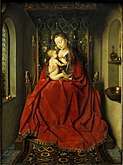 Jan van Eyck, Lucca Madonna
Jan van Eyck, Lucca Madonna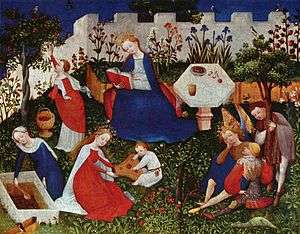 Oberrheinischer Meister, Paradiesgärtlein
Oberrheinischer Meister, Paradiesgärtlein Sandro Botticelli, Portrait of a Young Woman
Sandro Botticelli, Portrait of a Young Woman- Bartolomeo Veneto, Portrait of a Young Woman
 Rembrandt Harmensz van Rijn, The Blinding of Samson
Rembrandt Harmensz van Rijn, The Blinding of Samson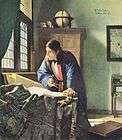
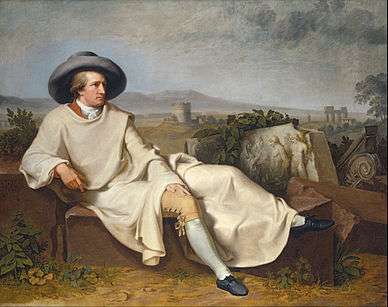 Johann Heinrich Wilhelm Tischbein, Goethe in the Roman Campagna
Johann Heinrich Wilhelm Tischbein, Goethe in the Roman Campagna Edgar Degas, Musicians in the Orchestra
Edgar Degas, Musicians in the Orchestra
Directors
The directors of the Städel Museum:
- Carl Friedrich Wendelstadt 1817–1840
- Philipp Veit 1830–1843
- Johann David Passavant 1840–1861
- Gerhard Malß 1861–1885
- Georg Kohlbacher 1885–1889
- Henry Thode 1889–1891
- Heinrich Weizsäcker 1891–1904
- Ludwig Justi 1904–1905
- Georg Swarzenski 1906–1937
- Ernst Holzinger 1938–1972
- Klaus Gallwitz 1974–1994
- Herbert Beck 1994–2006
- Max Hollein 2006–2016
- Philipp Demandt since 2016
Literature
- Eva Mongi-Vollmer: Meisterwerke im Städel Museum. Städel Museum, Frankfurt am Main 2007. ISBN 3-9809701-3-2
- Bodo Brinkmann: Das Städel, Frankfurt am Main. Prestel Verlag (Prestel-Museumsführer), München 1999, ISBN 3-7913-2204-4
- Bodo Brinkmann und Stephan Kemperdick: Deutsche Gemälde im Städel 1500–1550 (Kataloge der Gemälde im Städelschen Kunstinstitut Frankfurt am Main, hrsg. von Herbert Beck und Jochen Sander). Verlag Philipp von Zabern, Mainz 2005, ISBN 978-3-8053-3350-4
- John Charles Van Dyke (1914), "Staedel Institute, Frankfort", Munich, Frankfort, Cassel: critical notes on the Old Pinacothek, the Staedel Institute, the Cassel Royal Gallery, New York: C. Scribner's Sons
References
- "Historic Attendance Records for Schirn, Städel, and Liebieghaus in 2012" (PDF). Städel Museum. Retrieved 2015-04-16.
- Meyer, Corina (2017) The origins of the Städelschule (PDF). Retrieved 26 January 2018
- Howe, Thomas Carr. 1946. Salt Mines and Castles: The Discovery and Restitution of Looted European Art. New York: Bobbs Merrill. Pages 43–46.
- "Die Erweiterung des Städel Museums". Städel Museum. Retrieved 2012-10-14.
- Kneen, Dale (Summer 2012). "Starchitects In Our Eyes". High Life. British Airways: 16–17.
- "Städel Museum 2.0". Deutsche Welle. Retrieved 2015-04-16.